Imagine the man who transformed the world’s music scene with his flamboyant stage presence, yet was known for his reticent persona offstage. Picture someone who, in the confines of a bathtub, conjured up a hit that would rock the charts, and in another moment, shared laughter and improvised dialogues with royalty while watching “The Golden Girls.” This enigmatic figure fearlessly stood up to punk icons, yet harbored a fear of flying in small planes.
From lavish parties that legends are made of to intimate moments that reveal a softer side, the life of Freddie Mercury is a kaleidoscope of contrasts and surprises. As we peel back the layers of this remarkable individual, prepare to be enchanted by the fun facts about Freddie Mercury that showcase the multifaceted diamond he truly was.
1. Born Farrokh Bulsara: The Early Life of Freddie Mercury
Freddie Mercury, the iconic frontman of Queen, was originally born Farrokh Bulsara on September 5, 1946, in Stone Town, Zanzibar (now Tanzania). His parents, Bomi and Jer Bulsara, were Parsi-Indian, adhering to Zoroastrianism, a faith that influences the Parsi community to which they belonged. The family’s relocation to Zanzibar was due to Bomi’s job with the British Colonial Office.
The Bulsara family’s move to England in 1964, escaping the Zanzibar Revolution, marked a significant turn in young Farrokh’s life. In England, he pursued his passion for music and art, eventually studying graphic art and design at Ealing Technical College and School of Art, where his path crossed with future Queen bandmates. It was during these formative years in London that Farrokh Bulsara began transforming into Freddie Mercury, a name that would become synonymous with musical genius and flamboyant showmanship.
Mercury’s Parsi heritage and his upbringing in both Zanzibar and India played crucial roles in shaping his unique artistic vision and musical style. His choice of the stage name “Freddie Mercury” was a reflection of his desire to embrace a persona that transcended cultural and national boundaries, embodying the universal appeal of his music and performance.
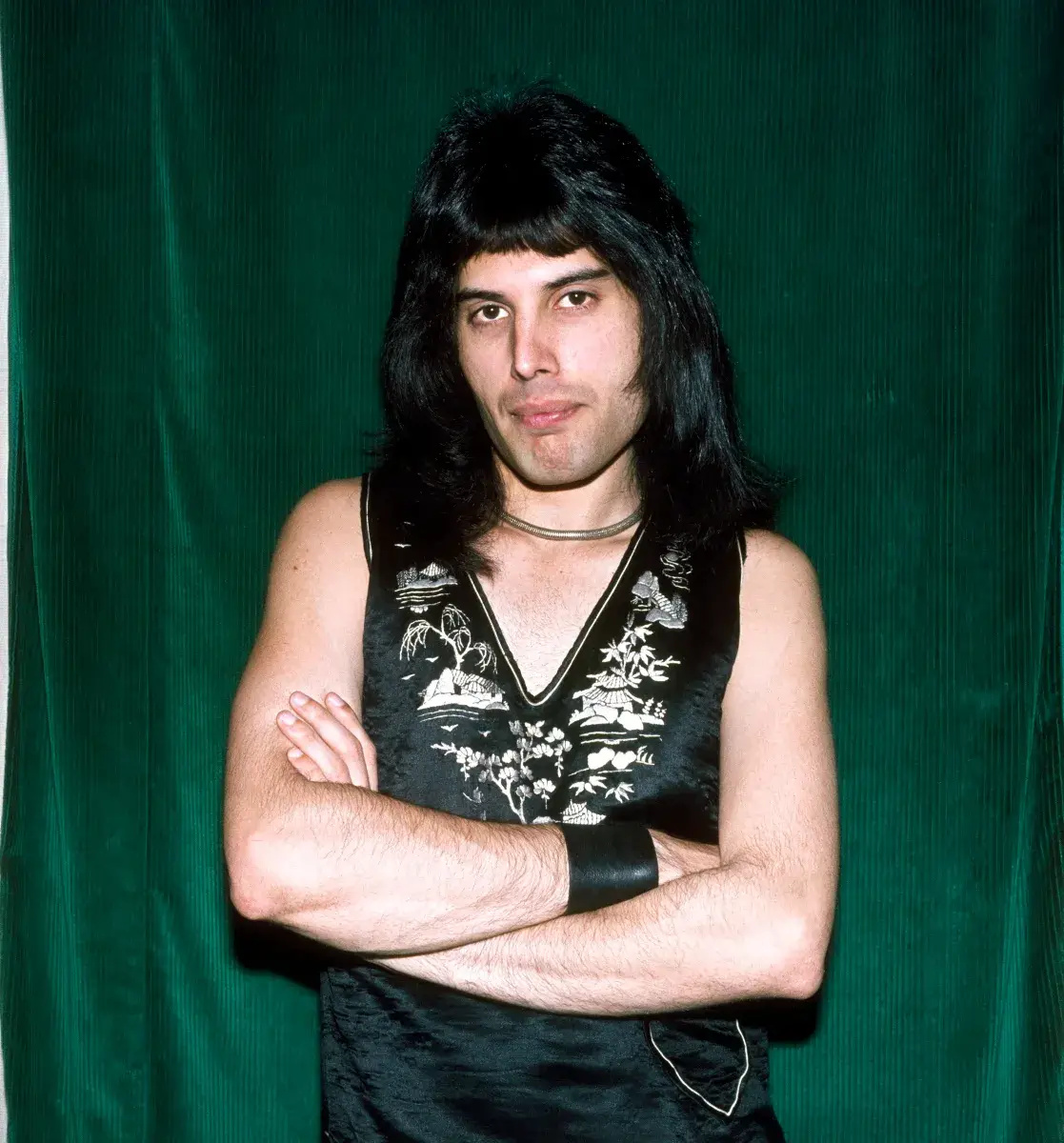
Freddie Mercury from his early career days. Image: nydailynews.com
2. Early Start in Music
Mercury’s musical journey commenced in India, where he took piano lessons starting at the age of seven, honing his skills and laying the groundwork for his future success. His education at St. Peter’s School, a boarding school in Panchgani, further nurtured his musical talent, setting the stage for his future as a performer.
This early exposure to music and performance played a crucial role in developing the skills he would later use to captivate audiences worldwide.
3. Friendship Between Freddie Mercury and Princess Diana
Princess Diana and Freddie Mercury’s friendship was characterized by their shared love for fun and defiance of conventional norms. Their most legendary escapade involved Mercury and comedian Kenny Everett dressing Diana in disguise for a night out at the Royal Vauxhall Tavern, a famous gay bar in London. This adventure showcased their playful spirit and Diana’s willingness to momentarily escape the scrutiny of royal life.
The evening was filled with laughter, with the group enjoying the anonymity and the thrill of the experience. Their friendship, although unlikely, was a testament to Diana’s broad appeal and ability to connect with people from all walks of life.
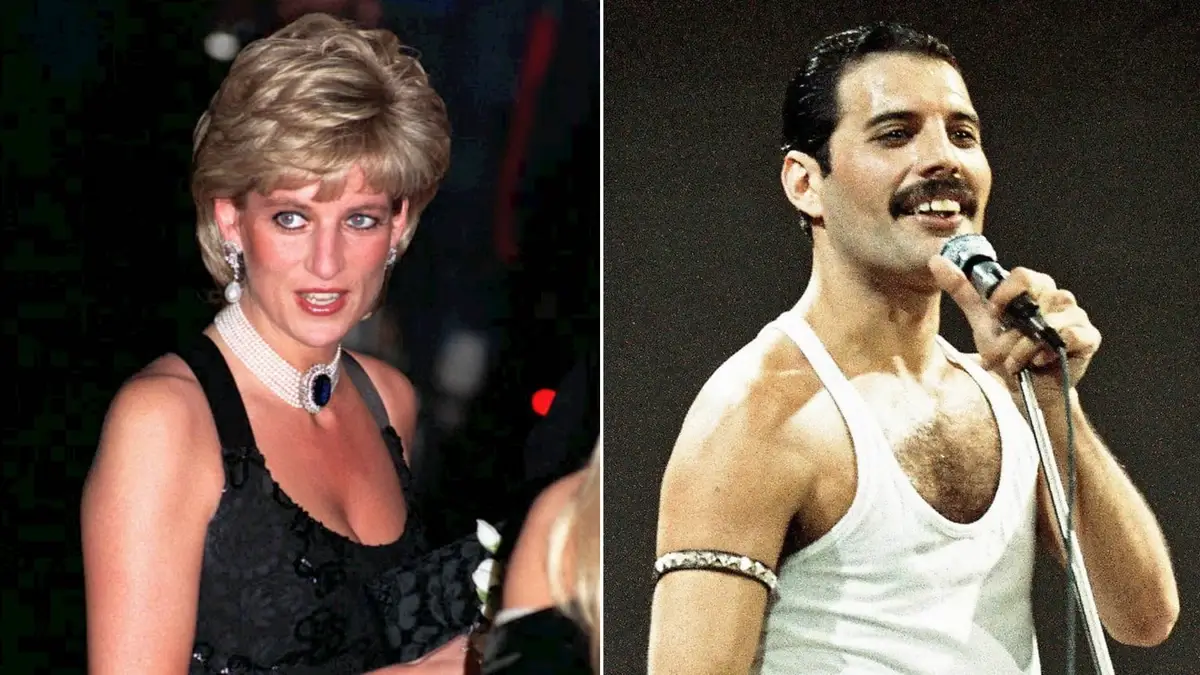
Image: thedailybeast.com
4. Freddie Mercury’s Ballet Performance with the Royal Ballet in 1979
In an unforgettable melding of rock and ballet, Freddie Mercury performed with the Royal Ballet on October 7, 1979. This event not only showcased his unparalleled stage presence but also his deep appreciation for the ballet. Mercury performed to Queen’s hits “Bohemian Rhapsody” and “Crazy Little Thing Called Love,” integrating non-traditional choreography that captivated the audience. His infectious energy and the novelty of a rock star performing in such a classical setting made the evening memorable.
Despite having no formal ballet training, Mercury’s dedication was evident. He underwent ballet lessons in preparation, demonstrating his commitment to the performance and his desire to bridge the gap between rock music and classical ballet. This crossover thrilled audiences, highlighting Mercury’s versatility as a performer and his willingness to explore and embrace different art forms.
5. Inspiration in the Bathtub
In a moment of spontaneous creativity, Freddie Mercury conceived the hit song “Crazy Little Thing Called Love” while immersed in the bubbles of a bathtub in Munich’s Bayerischer Hof hotel in 1979. This anecdote exemplifies Mercury’s unique approach to songwriting, often driven by intuition and the spur of the moment. Despite its quick genesis, this song marked a significant departure from Queen’s typical style, leaning towards a rockabilly vibe that paid homage to Elvis Presley. The simplicity of the composition, attributed to Mercury’s limited guitar skills, proved to be its strength, capturing the essence of rock’n’roll with an infectious beat and straightforward lyrics.
Mercury’s venture into rhythm guitar for this track underscored the song’s distinct departure from the complex, layered productions Queen was known for, such as “Bohemian Rhapsody.” His limited familiarity with the guitar inadvertently funneled his creative energies into crafting a hit that resonated with audiences worldwide, achieving number one status in the United States and numerous other countries. The song’s charm lies not just in its melody and lyrics but in the story of its creation, a testament to Mercury’s genius and his ability to find musical inspiration in the most ordinary circumstances.
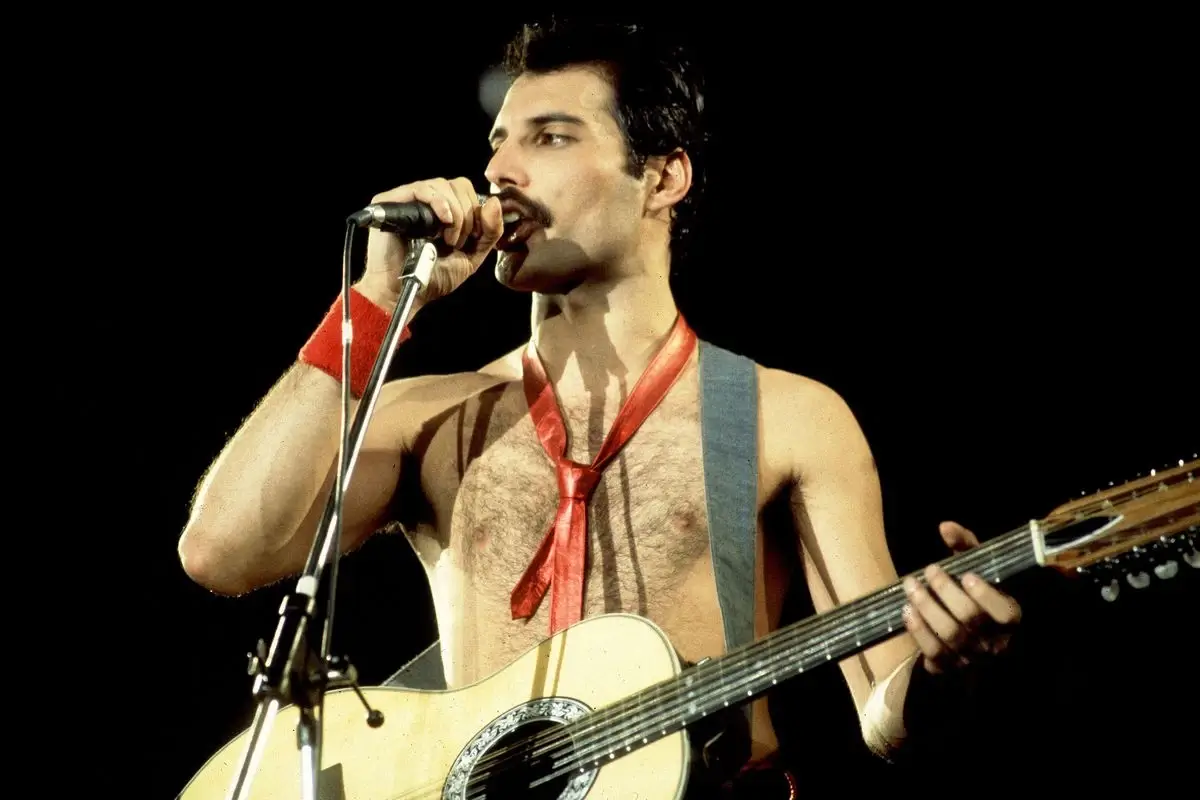
Image: biography.com
6. The “Hair, Nose, and Teeth” Supergroup Fantasy
Freddie Mercury, Elton John, and Rod Stewart, three monumental figures in rock history, once flirted with the idea of creating a supergroup. Dubbed “Hair, Nose, and Teeth” for their notable features—Stewart’s nose, John’s hair, and Mercury’s teeth—this concept highlighted their camaraderie and shared humor. Despite the potential for a groundbreaking collaboration, the idea remained a playful speculation among them.
This fleeting thought of combining their distinctive talents and personalities excited not only the artists themselves but also fans and music enthusiasts. Yet, the supergroup idea never evolved past informal discussions during gatherings at Mercury’s home. The notion of these icons uniting musically tantalizes with “what could have been,” showcasing the imaginative spirit that defined their careers.
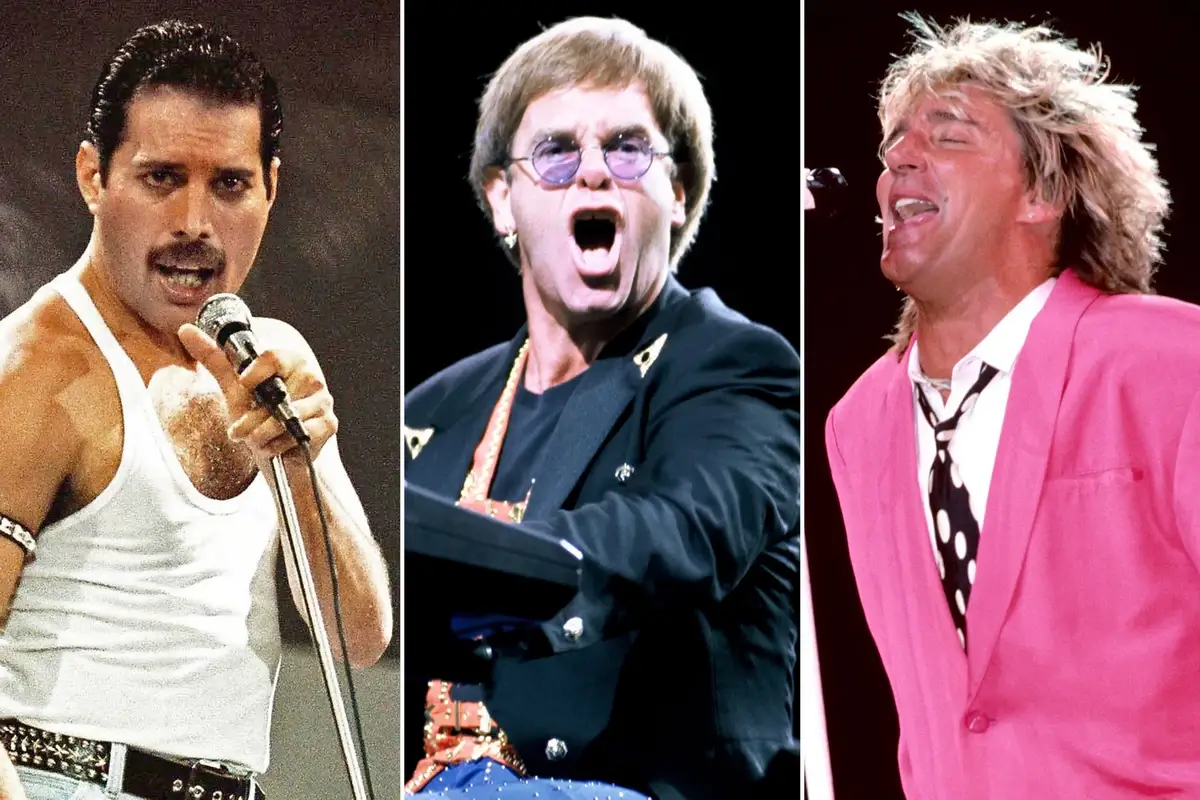
Freddie Mercury, Elton John, and Rod Stewart. Image: nypost.com
7. Troubled Collaborations with Michael Jackson
The collaboration between Freddie Mercury and Michael Jackson, two of the biggest icons in the music industry, was highly anticipated but ultimately derailed by unusual circumstances, including the presence of Jackson’s pet llama in the studio. The sessions, planned in the early 1980s, were supposed to blend the unique talents of the Queen frontman and the King of Pop. However, Mercury found the studio environment, particularly the llama’s presence, intolerable. This bizarre scenario led to Mercury calling his manager, Jim ‘Miami’ Beach, to express his desire to leave the recording session. Mercury’s discomfort was evident when he communicated that he was recording with a llama and had reached his limit.
The potential collaboration had the makings of music history, with Mercury later reflecting that one of their tracks might have been featured on Jackson’s “Thriller” album had they completed it. This missed opportunity is highlighted in anecdotes shared in the DVD “Freddie Mercury: The Great Pretender,” showcasing what could have been a groundbreaking partnership between these music legends.
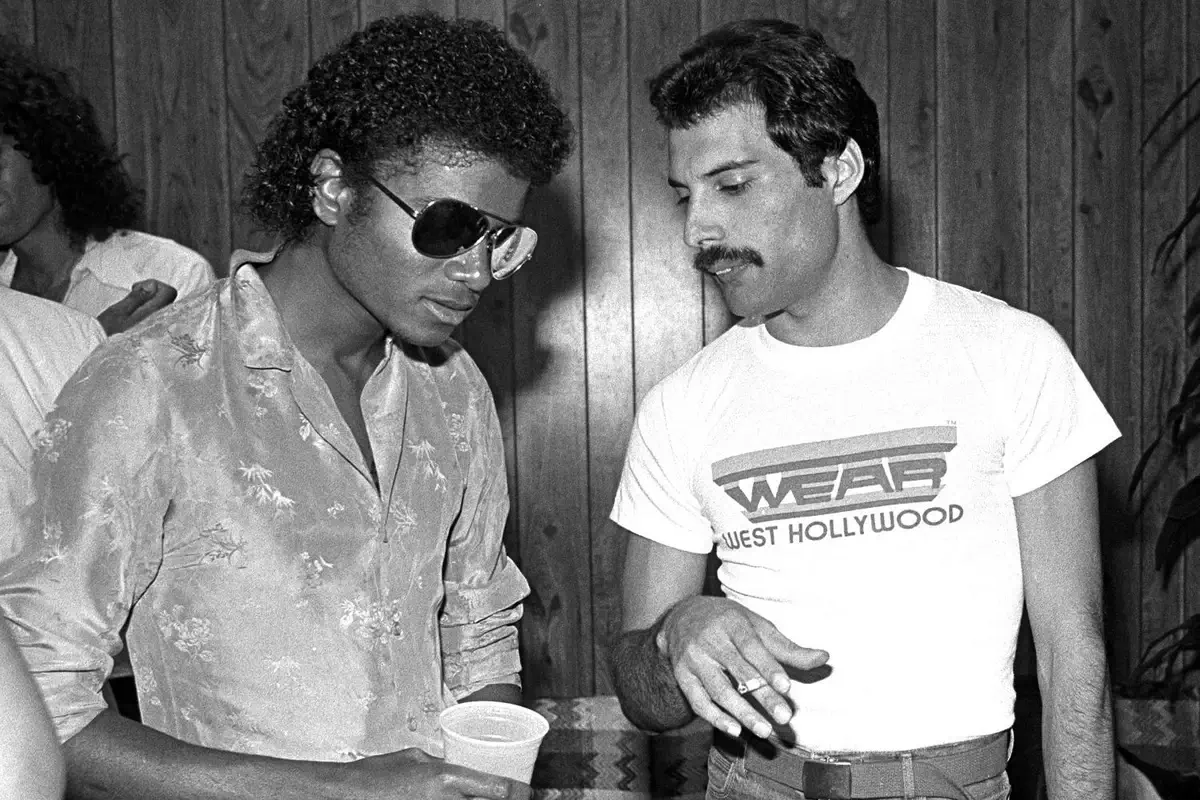
Freddie Mercury and Michael Jackson. Image: thetimes.co.uk
8. Freddie Mercury’s Feline Phone Calls
Freddie Mercury, known for his extravagant stage presence, had a softer side shown through his deep affection for his cats. While on tour, he would regularly phone home, not just to catch up with human loved ones, but to talk to his cats, expressing how much he missed them.
This act of calling his cats highlights Mercury’s loving and nurturing nature, treating them as integral members of his family.
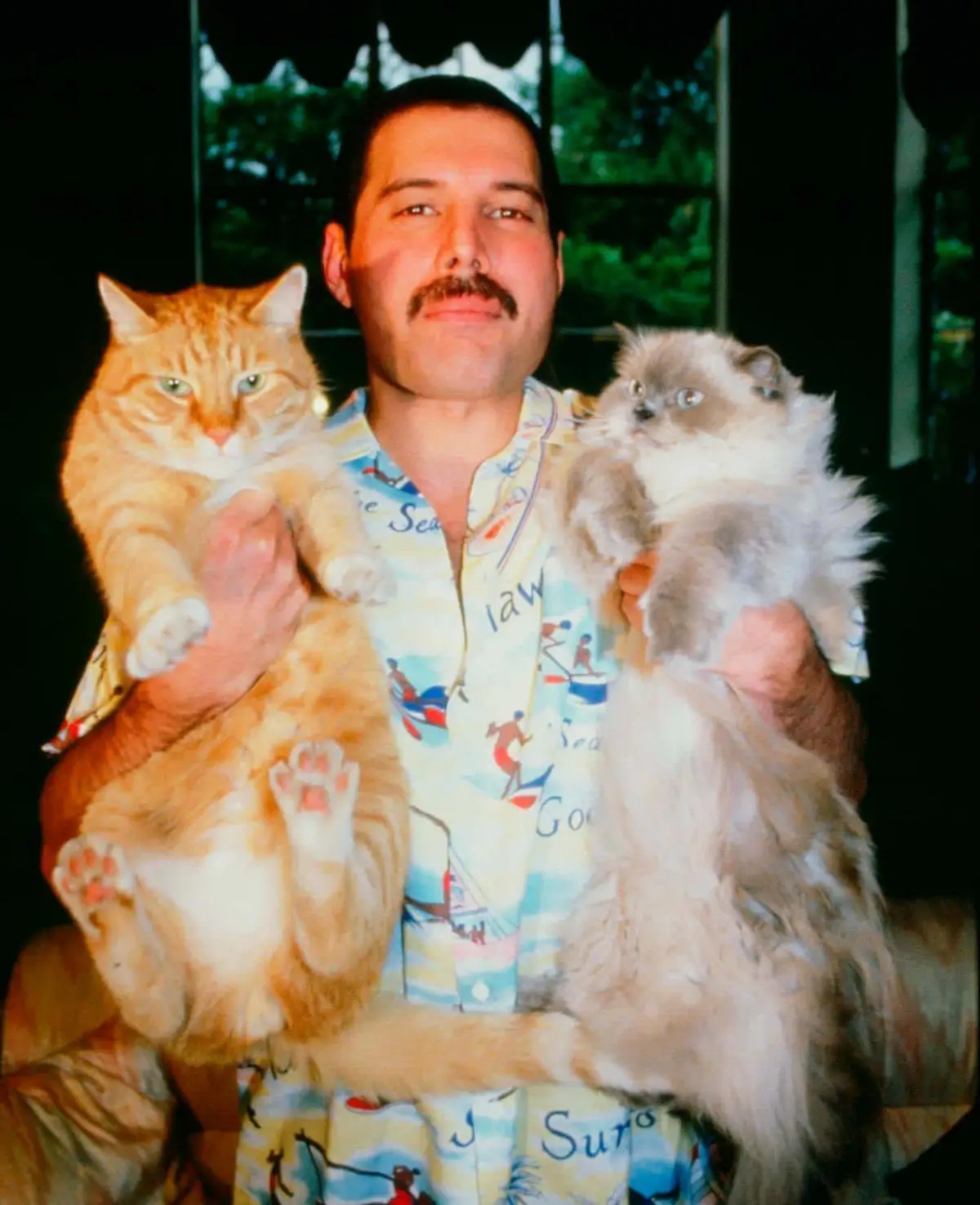
Freddie Mercury with his cats. Image: X.com
9. Solo Songwriting: Mercury’s “Mr. Bad Guy”
Freddie Mercury’s solo album “Mr. Bad Guy,” released in 1985, stands as a bold statement of his musical genius, with every track penned by Mercury himself. This endeavor allowed him to explore beyond the rock dominion of Queen, dabbling in genres from pop to disco. The album highlights Mercury’s versatility and deep personal connection to his music, offering insights into his creative process.
Recorded at Musicland Studios in Munich, “Mr. Bad Guy” was a showcase of Mercury’s multifaceted talent, not only as a songwriter but also a performer, handling vocals, piano, and synthesizer. Despite a lukewarm initial reception, the album’s significance has grown, especially after Mercury’s passing, underscoring his unique place in music history. The tracks “I Was Born to Love You” and “Made in Heaven” were later reimagined by Queen, blurring the lines between his solo work and his contributions to the band.
“Mr. Bad Guy” remains a testament to Freddie Mercury’s artistic independence, underlining the enduring appeal of his musical legacy.

Image: evo.audio
10. “Wayne’s World” Approval
When “Wayne’s World” decided to feature Queen’s “Bohemian Rhapsody” in its iconic car scene, it wasn’t just a pivotal moment for the film but also for Queen’s legacy, especially in the United States where their popularity had waned during the 1980s. Freddie Mercury, in his final days, was shown the scene and his reaction was nothing short of joyful and approving.
Mercury, despite his deteriorating health, laughed and smiled at the scene, fully enjoying the humor and creativity that mirrored Queen’s own ethos. Brian May, Queen’s guitarist, played the scene for Mercury, who expressed his delight and saw the humor and brilliance in the use of the song. Mercury’s reaction was a testament to his spirit, even in his final days, and underscored his approval of the song’s inclusion in the film, which he recognized as a bridge back to American audiences.
This moment, shared among Mercury, May, and the “Wayne’s World” team, symbolized more than just a mutual appreciation for a comedic scene; it represented a full-circle moment for Queen. The band, particularly Mercury, understood the sketch’s potential to reintroduce their music to a new generation in the U.S., a country where they had struggled to maintain their earlier levels of fame.
11. Fear of Small Planes
During Queen’s 13 major tours, Freddie Mercury had to confront his deep-seated fear of flying, especially in small aircraft. This phobia was particularly pronounced when the band had to travel on a small jet in South America.
Despite his global fame and the necessity of frequent flights for international tours, Mercury found these experiences terrifying. He admitted to being petrified and gripping the armrests with white knuckles during flights on smaller planes, contrasting sharply with his confident public persona.
To the outside world, including the photographers waiting for him, Mercury presented a facade of calm, stepping off the plane with a smile as if unfazed by the experience.
12. Broadway Invitation: Freddie Mercury’s “La Bohème” Offer
Freddie Mercury was invited to star in “La Bohème” on Broadway with Linda Ronstadt. Despite his diverse vocal talent, Mercury declined, citing the intense schedule of Broadway shows as incompatible with his lifestyle and artistic preferences.
This offer underscores his recognition in broader musical circles beyond rock, showcasing the versatility and range of his voice. Mercury’s reluctance also highlights his commitment to the freedom and spontaneity of his performances, contrasting the structured environment of opera and theater.
13. Freddie Mercury’s Scrabble Passion
Freddie Mercury’s off-stage persona included a passion for Scrabble, showcasing a competitive yet intellectual side of the Queen frontman. Known for his theatrical performances, Mercury’s love for words found a quieter, yet equally competitive arena in the form of Scrabble games. This pursuit wasn’t just a pastime; it was a tour staple, bringing out a different kind of creativity and strategic thinking from the singer.
Mercury and his bandmates, particularly Roger Taylor, indulged in marathon Scrabble sessions while touring. These games were intense, with Mercury being particularly adept at the game, often outscoring others with fewer tiles. Brian May holds the record for the highest-scoring word among them, “lacquers,” landing on a triple word score for a whopping point tally. This detail highlights the band’s camaraderie and intellectual engagement off-stage, contrasting with their rock star personas.
Mercury’s fascination with Scrabble extended beyond mere entertainment; it was an activity deeply ingrained from his early years, cultivated during time spent with an elderly aunt. His strategic acumen in the game was such that recording sessions could be paused for the thrill of the game, demonstrating his dedication to and love for Scrabble. This passion for wordplay also intersected with his music; the daily word puzzles in newspapers were another domain where Mercury excelled, often celebrating his victories with characteristic theatricality.
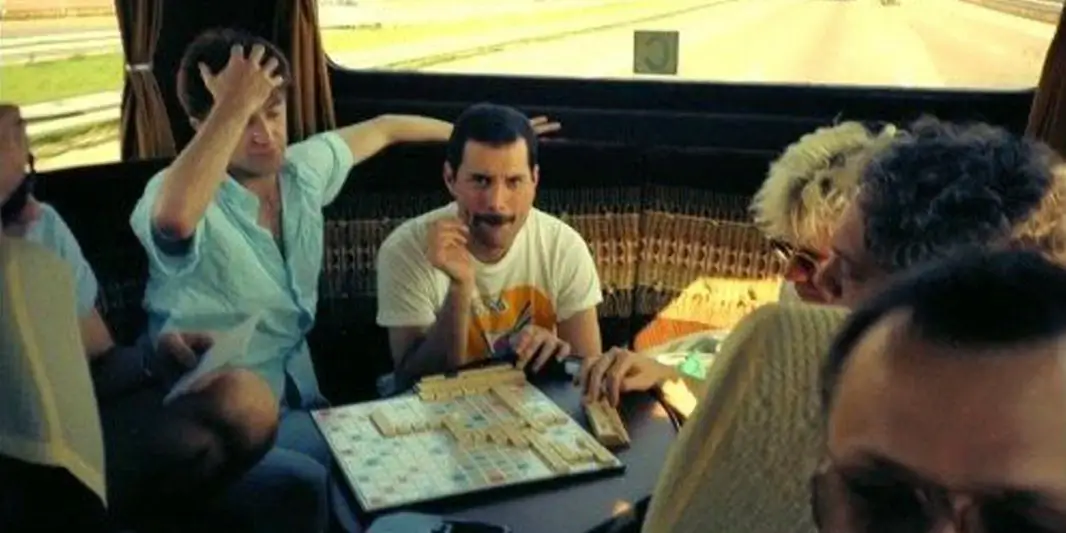
Image: Reddit
14. Passion for Opera
Freddie Mercury’s deep appreciation for opera significantly influenced Queen’s groundbreaking hit “Bohemian Rhapsody,” merging rock and opera into a unique and unforgettable musical experience. Mercury’s admiration for opera, especially the works of icons like Maria Callas and the operas of Puccini, served as a creative catalyst for the song, which became the centerpiece of the album “A Night at the Opera.”
“Bohemian Rhapsody” is renowned for its complex structure, encompassing various musical styles within a single track. The song’s operatic section, with its elaborate harmonies and theatrical dynamics, parodies classical opera, incorporating elements like bombastic choruses and a mock recitative. Mercury’s ingenious fusion of rock and opera in “Bohemian Rhapsody” showcased not only his versatile songwriting skills but also his ability to cross musical boundaries, making opera accessible to a wider audience. The song’s lyrical references to figures such as Scaramouche, Galileo, and Beelzebub, alongside cries of “Bismillah,” further emphasize its eclectic and dramatic nature.
Mercury’s opera-inspired vision for “Bohemian Rhapsody” was realized through intricate recording techniques, involving extensive overdubs and innovative use of the studio technology available at the time. The song’s success and its enduring legacy are testaments to Mercury’s pioneering approach to music, blending classical and rock elements in a way that had never been done before.
15. Artistic Beginnings: Freddie Mercury at Ealing Art College
Before Freddie Mercury became the iconic frontman of Queen, he nurtured a dream of becoming an artist. His journey into the world of art and design began at London’s prestigious Ealing Art College, where he enrolled to study graphic art and design, graduating in 1969. This institution, known for its contribution to the creative and musical spheres, has seen the likes of other notable musicians like Pete Townshend of The Who and Ronnie Wood of The Rolling Stones, among its alumni.
Mercury’s time at Ealing was not just an academic pursuit; it was here that his creative and performance skills flourished, laying the groundwork for his future in music. While his initial aim might have been to pursue a career in art, Mercury’s passion for music quickly took precedence. Nonetheless, the skills he acquired at Ealing were not lost. Mercury adeptly applied his artistic talents to design the heraldic arms for Queen, a symbol that has become synonymous with the band’s identity.
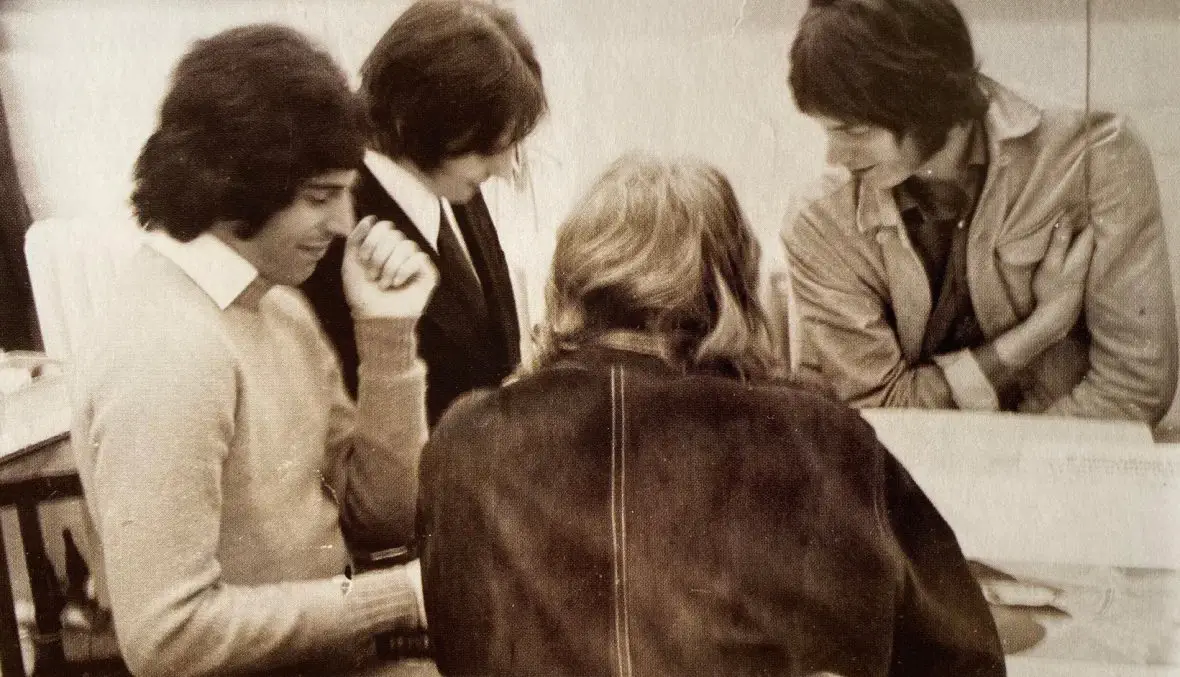
Freddie Mercury during his college days. Image: rutlandantiques.co.uk
16. Multi-Instrumentalist Genius
Freddie Mercury, the legendary frontman of Queen, was celebrated for his extraordinary vocal range and electrifying stage presence. However, his musical talents extended far beyond his voice. A true multi-instrumentalist, Mercury could play the piano, guitar, and had a knack for drums as well.
Mercury’s prowess on the piano is perhaps the most well-documented, serving as the backbone for many of Queen’s hits, including the iconic “Bohemian Rhapsody.” His ability to blend classical techniques with rock sensibilities gave Queen’s music a distinctive, timeless quality. From the band’s early days until his last performances, Mercury used a variety of pianos on stage, including a Steinway that became a staple for live concerts from November 1977 onwards.
Mercury’s guitar skills, while less spotlighted, were integral to Queen’s sound. Described by bandmate Brian May as “very unorthodox” due to his preference for all downstrokes, Mercury’s approach to the guitar contributed to the creation of riffs for songs like “Ogre Battle”. His capability on the guitar showcases his musical versatility and deep understanding of rock music’s essence.
Though not as prominently featured, Mercury’s ability to play drums contributed to his comprehensive understanding of music composition and arrangement, further solidifying his status as a versatile musician. His broad skill set allowed him to have a significant role in the songwriting process, enabling him to express his creative vision across Queen’s discography.
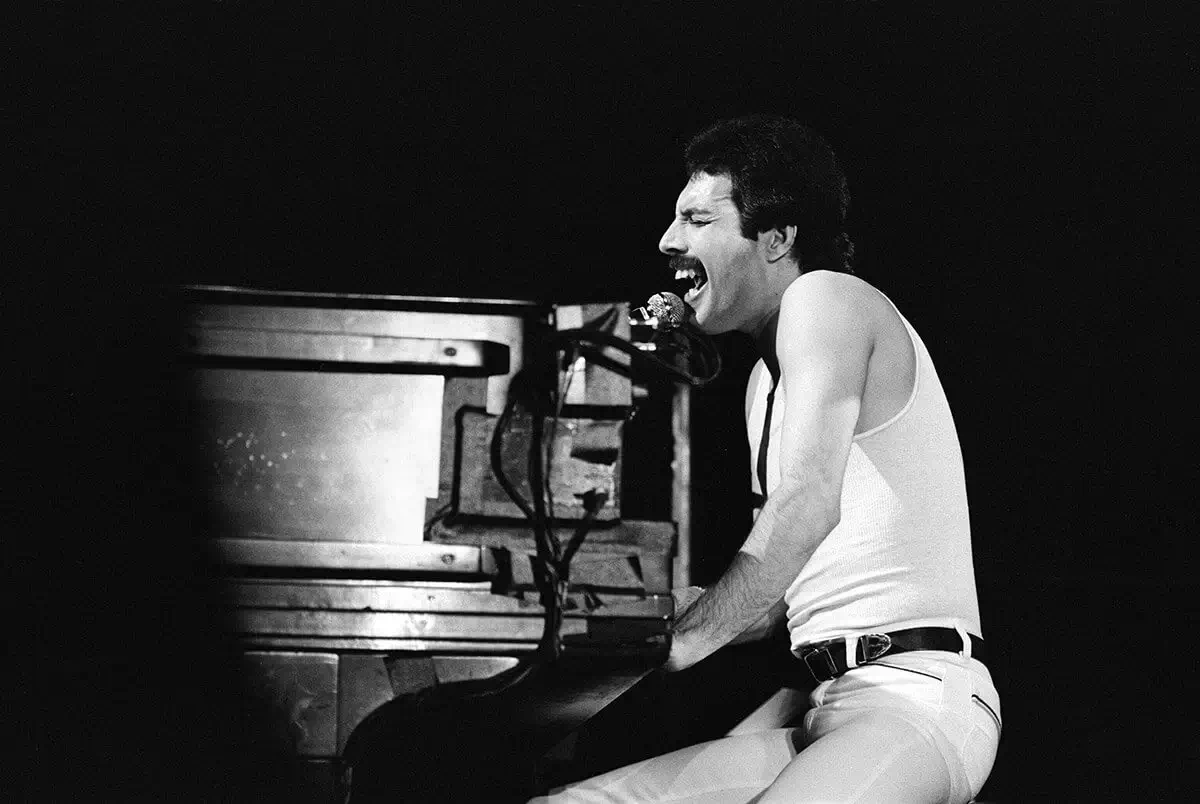
Image: mavink.com
17. Rich Vocal Range: The Phenomenon of Freddie Mercury
Freddie Mercury’s vocal range was a marvel in the world of music, demonstrating a versatility that spanned from bass low F (F2) to soprano high F (F6), covering most of the tenor range. This extensive range allowed him to deliver performances that ranged from a “deep, throaty rock-growl to tender, vibrant tenor, then on to a high-pitched, perfect coloratura, pure and crystalline in the upper reaches”. Despite the common belief that Mercury’s vocal range spanned four full octaves, researchers have been fascinated by his unique ability to use “false vocal cords” for a distinctive growl, a technique not commonly employed by singers.
This remarkable vocal agility placed Mercury among the icons of music, with a range that could easily be compared to other musical greats. His ability to navigate through complex melodies with ease and expressiveness made Queen’s music universally beloved and timeless. It was not just the range but the unique timbre, control, and emotional expression in Mercury’s voice that left an indelible mark on audiences and fellow musicians alike.
18. Nom de Plume: Freddie Mercury as Larry Lurex
Before the world knew him as the flamboyant frontman of Queen, Freddie Mercury experimented with a stage persona named Larry Lurex. This endeavor occurred in the early 1970s, as Mercury and his bandmates were on the brink of launching their iconic careers. The name “Larry Lurex” was a playful jest, a tongue-in-cheek response to the glam rock movement epitomized by artists like Gary Glitter. Mercury’s choice of the moniker was both a pun and a personal commentary, reflecting his unique sense of humor and perhaps his early instincts about the characters within the music industry.
In 1973, under the Larry Lurex guise, Mercury released a couple of singles, notably covers of “I Can Hear Music” (originally by The Beach Boys) and “Goin’ Back” (by The Byrds). These tracks were part of a project initiated by Trident Studios’ engineer Robin Geoffrey Cable. Interestingly, Mercury involved his future Queen bandmates, Brian May and Roger Taylor, in the recording process, making these singles an obscure but fascinating footnote in the band’s history. Despite the release under this pseudonym, the records were essentially Queen in their nascent form, hinting at the extraordinary talent and creativity that would soon captivate the world.
19. Humble Beginnings: Freddie Mercury at Heathrow Airport
Before the flamboyant performances and the rock anthems that would define a generation, Freddie Mercury’s life was markedly different. In the early days, long before he became the legendary frontman of Queen, Mercury worked as a baggage handler at London’s Heathrow Airport. This job was part of his life in England after fleeing the violence of the Zanzibar Revolution with his family. It was a time of humble beginnings, where the future star was handling luggage instead of captivating stadiums full of fans.
In 2018, to commemorate what would have been Mercury’s 72nd birthday, British Airways and the staff at Heathrow paid homage to their former employee in a unique way. Baggage handlers at the airport performed a choreographed dance to Queen’s hit “I Want to Break Free,” a fitting tribute to Mercury’s journey from handling baggage to breaking free and becoming a global music icon. This celebration highlighted the extraordinary path Mercury took from his ordinary job at the airport to rock royalty.
20. Spiritual Journey: Freddie Mercury’s Exploration of Faith
Freddie Mercury’s spiritual journey is as fascinating as his musical career. Born Farrokh Bulsara in Zanzibar to Parsi parents from India, Mercury was raised in the Zoroastrian faith, one of the world’s oldest monotheistic religions. This ancient faith deeply influenced his life and work, instilling values that he carried throughout his career.
Zoroastrianism, founded by the prophet Zarathustra in ancient Persia, emphasizes the dualism of good and evil and the importance of choosing the path of righteousness. It introduced theological concepts like heaven and hell and had a profound influence on later monotheistic religions. Despite the profound cultural and spiritual legacy of Zoroastrianism, Mercury was not overtly religious in his public life. However, the principles of his faith—hard work, perseverance, and following one’s dreams—were evident in his approach to life and music.
Mercury’s sister, Kashmira Cooke, highlighted how their Zoroastrian faith encouraged them to pursue their passions and to live by the religion’s motto of “Good Thoughts, Good Words, Good Deeds.” This ethos was reflected in Mercury’s generosity and his determination to follow his dreams against all odds. Even though he did not practice Zoroastrianism in a traditional sense as an adult, its teachings on morality, kindness, and the struggle between good and evil left a lasting imprint on his worldview.
21. Shy Offstage Persona
Freddie Mercury, the charismatic frontman of Queen, dazzled millions with his electrifying performances and flamboyant stage presence. Yet, away from the spotlight, he embodied a starkly contrasting persona. Despite his onstage bravado, Mercury was known to be remarkably shy in his personal life, revealing a complexity that endeared him to fans and friends alike.
Mercury’s shyness wasn’t just a quirk; it was a fundamental aspect of his character that influenced his interactions with the world around him. Offstage, he often sought refuge from the public eye, craving moments of solitude or the company of close friends in more intimate settings.
This dichotomy was noted by those within his inner circle and by Mercury himself in rare interviews. Despite the adulation he received from fans worldwide, Mercury admitted to feeling vulnerable and exposed in the glare of the media spotlight, often preferring the sanctity of his home or the studio where he could express himself without the weight of expectation.
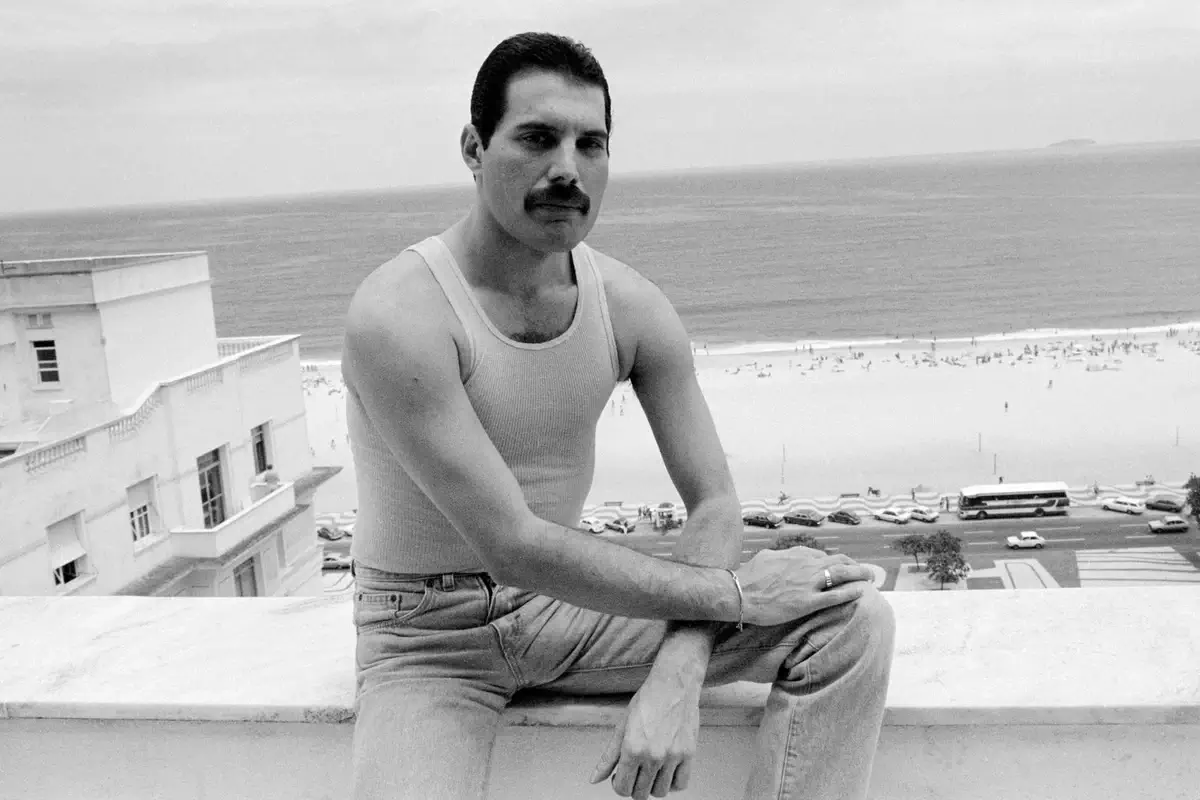
Image: yimg.com
22. Secret Identity: Freddie Mercury’s Pseudonym Shenanigans
Freddie Mercury, seeking privacy amidst fame, often checked into hotels as “Mr. Singh.” This pseudonym was a simple yet effective way for the Queen frontman to evade public and media attention, granting him moments of anonymity.
This practice underscores Mercury’s need for personal space, contrasting with his flamboyant public persona. It reflects the lengths celebrities go to preserve privacy in their personal lives.
23. Lover of Gardening
Freddie Mercury’s grand persona on stage was matched by a surprisingly domestic passion off it: gardening. The Queen frontman found solace and joy in the tranquility of his garden at his London home. This lesser-known facet of Mercury’s life reveals a man who cherished the simple pleasure of tending to his plants and flowers.
In the final months of his life, Mercury, despite his declining health, made an effort to engage with his garden. He was photographed in his garden, a space he had loved, providing a poignant image of the star in one of his places of comfort. This image, captured in August 1991, is a testament to his enduring love for his garden, even as he faced his final days.
Mercury’s garden was more than just a hobby; it was a refuge from the whirlwind of fame and a source of simple, pure joy. His engagement with gardening, especially during the challenging times of his life, highlights a personal pursuit of beauty and serenity away from the public eye.
These glimpses into Mercury’s private life, such as his love for gardening, enrich our understanding of him as a complex individual beyond his public persona. They remind us that amidst the extraordinary life he led, he also sought the ordinary, grounding experiences that gardens provide.
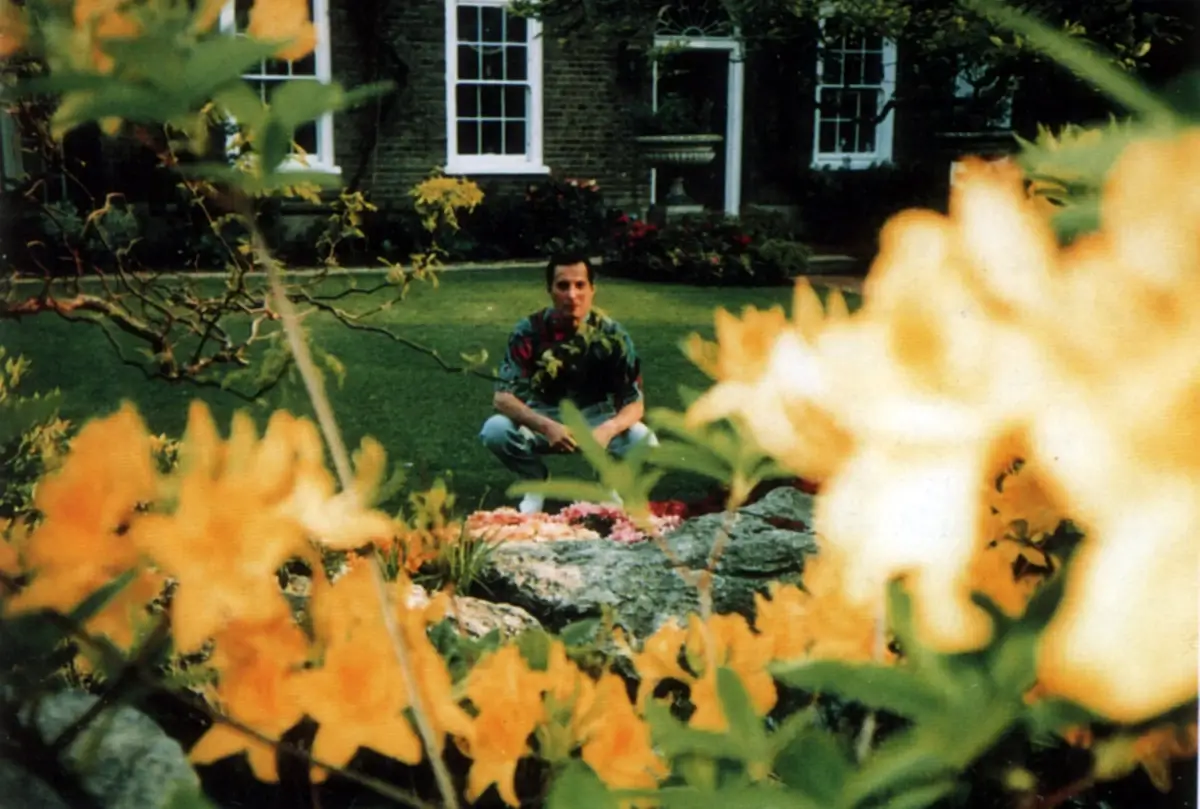
Freddie Mercury in his garden. Image: queenphotos.wordpress.com
24. Musical Collaborations: Freddie Mercury and Montserrat Caballé’s “Barcelona”
In a striking departure from rock, Freddie Mercury joined forces with opera legend Montserrat Caballé to create the album “Barcelona” in 1988. This collaboration marked a significant moment in music, blending rock and opera in a way that had rarely been seen before. Mercury, known for his dynamic presence as Queen’s frontman, ventured into the operatic realm, fulfilling a lifelong ambition to merge these two diverse musical genres.
The inception of “Barcelona” occurred after Mercury expressed his desire to work with Caballé, leading to their first meeting in 1986 at The Ritz hotel in Barcelona. Mercury presented “Exercises In Free Love” to Caballé, a piece he had prepared especially for her, singing in falsetto to imitate her style. Caballé was so impressed that she immediately agreed to collaborate, marking the beginning of their iconic partnership.
Recording took place in early 1987 at Mountain Studios in Montreux, Switzerland, where they worked tirelessly to craft an album that truly represented a fusion of their distinct musical worlds. Despite initial suggestions for Mercury to sing in baritone, he remained true to his rock roots, ensuring his fans would still recognize his signature style.
The album featured eight tracks, including the hit single “Barcelona,” which later became associated with the 1992 Olympics held in the city. Despite Mercury’s passing before the event, the song played a significant role in the Olympics, symbolizing his lasting impact on the music world.
25. Immortalized in Film: “Bohemian Rhapsody”
“Bohemian Rhapsody,” the 2018 biographical musical drama, not only celebrated the life and legacy of Freddie Mercury but also brought the story of Queen’s rise to fame to a new generation of fans. Directed initially by Bryan Singer, with later contributions by Dexter Fletcher, the film stars Rami Malek in a career-defining role as the flamboyant and incredibly talented Freddie Mercury. Despite mixed reviews from critics, particularly regarding its use of creative license and portrayal of Mercury’s life, the film was a box office sensation, grossing over $910 million worldwide. It became the highest-grossing musical biographical film of all time, a testament to its widespread appeal and the enduring legacy of Queen’s music.
The film’s cultural significance lies not just in its financial success but in its impact on Queen’s music, introducing classics like “Bohemian Rhapsody,” “We Will Rock You,” and “Another One Bites the Dust” to those unfamiliar with the band’s discography. The meticulous attention to detail in the Live Aid concert reenactment and the portrayal of Mercury’s complex personality and private struggles were particularly praised. Malek’s portrayal of Mercury earned him an Academy Award for Best Actor, among the film’s four Oscars, highlighting the film’s excellence in acting and technical achievements.
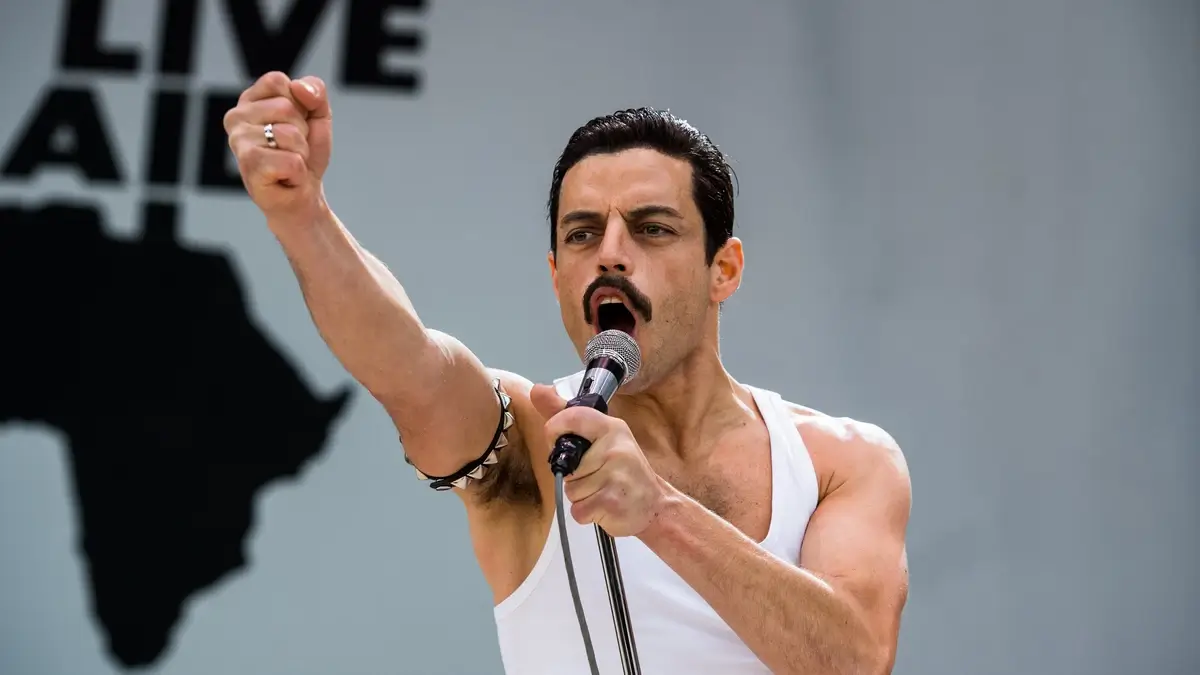
Rami Malek in character as Freddie Mercury. Image: npr.org
FAQ
What were Freddie Mercury’s hobbies?
Freddie Mercury’s hobbies included collecting art, especially Japanese art, and antique furniture. He was also passionate about opera and ballet, attending performances regularly. Mercury loved cats and had several of them as pets throughout his life, treating them with great affection and often referring to them in his music and interviews.
What was Freddie Mercury’s favourite food?
Freddie Mercury’s favourite foods are reported to have been varied, including Indian cuisine, which reflects his Parsi heritage, and Japanese food. He was known to enjoy a lavish lifestyle that included fine dining, but specific dishes that he favored are not widely documented.
Did Freddie Mercury play any sports?
Freddie Mercury was not known for participating in sports actively. He was much more involved in music, performance, and the arts. There is no significant record of him engaging in sports either for leisure or competitively.
What are some interesting facts about Freddie Mercury’s childhood?
Interesting facts about Freddie Mercury’s childhood include his birth on the island of Zanzibar, his real name being Farrokh Bulsara, and his attendance at boarding school in India, where he formed his first band, The Hectics. He moved to England in his teens, which was a pivotal move for his future career in music.
What was Freddie Mercury’s famous quote?
One of Freddie Mercury’s most famous quotes is, “I won’t be a rock star. I will be a legend.” This quote exemplifies his confidence and determination to leave a lasting impact on the music world, which he certainly achieved as the lead singer of Queen.
Did Freddie Mercury have friends?
Yes, Freddie Mercury had many friends throughout his life, including fellow band members of Queen, other musicians like Elton John and David Bowie, and his personal assistant, Peter Freestone. He was known for his generous and loyal nature to those he was close to.
Why is Freddie Mercury a hero?
Freddie Mercury is considered a hero by many for various reasons, including his groundbreaking contributions to music and performance, his courage in dealing with his AIDS diagnosis publicly, and his influence on the LGBT+ community. His exceptional talent, charisma, and advocacy for being true to oneself continue to inspire people worldwide.





